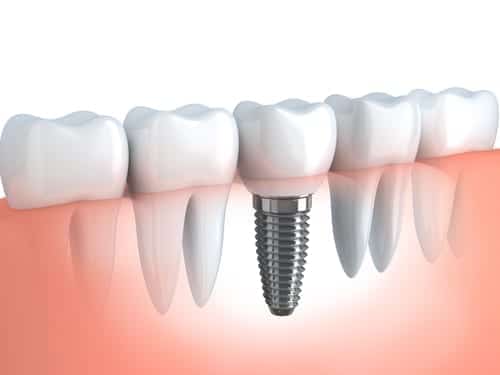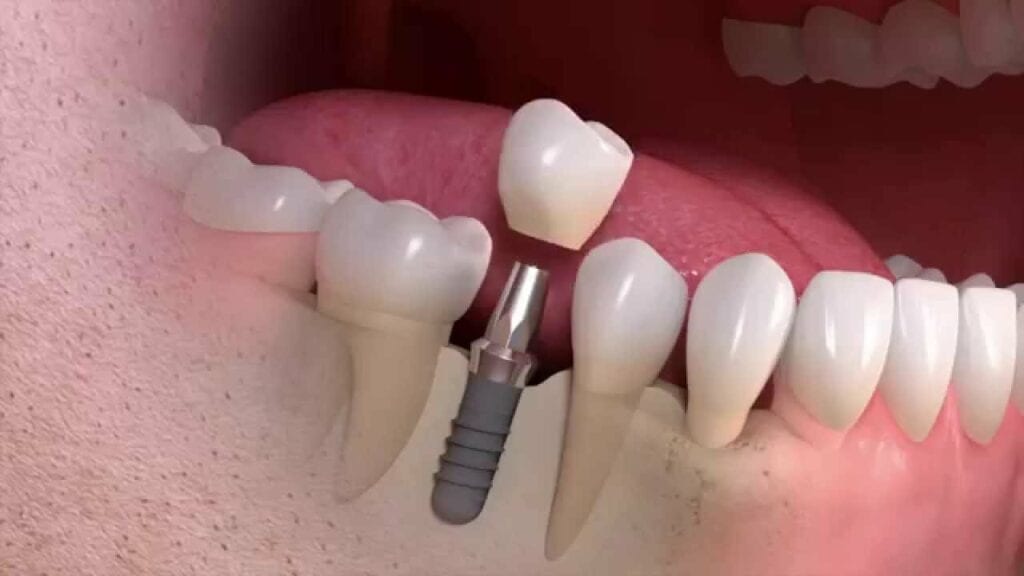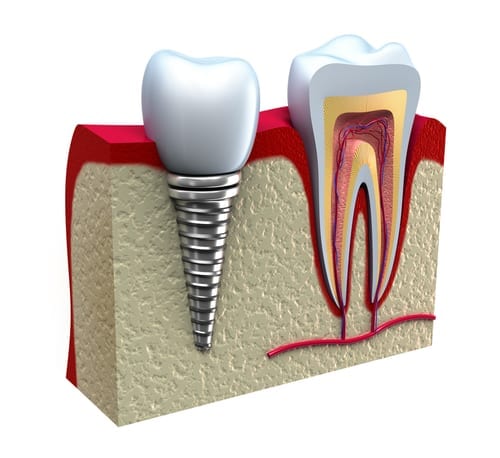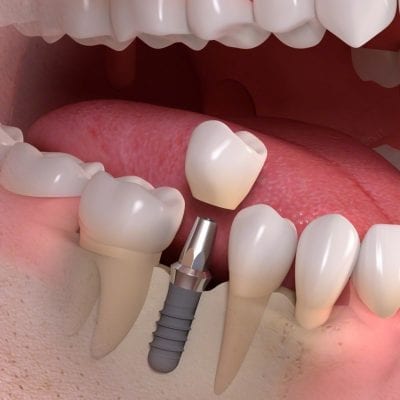Dental implants are frames or posts that are positioned through surgery right into the jawbone beneath the gums, usually on the tooth socket of a recently pulled tooth. This gives the implant a significant advantage over false teeth in terms of being as close as possible to natural teeth, including their placement into the jawbone itself. After they’ve been put into place, they enable the dentist to mount replacement teeth like crowns or a dental bridge over them.
More than 60 companies in the world are responsible for manufacturing or creating dental implants and/or materials for dental restorations that are put on top of these artificial tooth anchors. It is indeed a big business in the dental industry. Because of this, dentists have quite a handful of choices for the right treatment for their patients and each one’s unique dental case. This allows them to be more flexible when it comes to performing 21st century dental implant dentistry.
How Do Dental Implants Work?

Implants are fused to the jawbone so that they’ll serve as posts for dental restorations and artificial teeth. Bridges and dentures are mounted on these stable support structures in order to allow them to affix themselves to your mouth permanently. This comes with the following benefits:
- More Comfortable Fit: Implants ensure artificial teeth will fit comfortably within your mouth without shifting or slipping.
- Prevention of Shifting: Your missing teeth can also influence the shape of your face and the type of bite you have. By filling in that missing part with an implant or dental restoration, you can preserve the original bite and shape of your face.
- Improved Speaking and Chewing: Dental implants are especially beneficial if you want to speak clearly with perfect enunciation or chew your food properly when eating.
- Feels More Natural: Dental implants make dentures, individual crowns, and bridges that depend on the post for support feel more natural when worn, as compared to conventional dentures and bridges.
- Prevent Gagging, Poor Ridges, and Sore Spots: For some people out there, traditional dentures and bridges are uncomfortable or even impossible to use. This is because of gagging, poor ridges, and sore spots.
- No Need to Secure Using Other Teeth: With implants, bridges don’t need to be secured on either side or on one side of the space left by missing teeth through the remaining teeth.
- Avoid Grinding Down Healthy Teeth: The problem with non-implant bridges is that they need to ground or prepare healthy teeth down to serve as posts for the replacement tooth or teeth.
You need to have healthy gums and adequate bone mass to allow dental implantation. Otherwise, your bills for it might go up by requiring a special surgeon and bone grafting to your jaw. At any rate, both the gingiva and the maxillary/mandibular structures must be kept healthy in order for you to become a dental implant candidate.
Tooth Loss and Determining Your Type of Implant
You typically require dental implants when you lose one or more of your teeth and there are large gaps between your healthy teeth due to all the missing teeth. You can lose a tooth for a variety of reasons. They include the following:
- Congenital defects
- Excessive dental wear and tear
- Teeth falling out due to looseness
- Tooth decay and severe dental caries
- Mouth trauma leading to tooth injury
- Advanced gum disease or periodontitis
- Failure of saving the tooth after a root canal procedure
- Tooth destruction and tooth root inflammation requiring extraction
In order to figure out if the implants you’re considering are the right ones for you, you need to talk to your dentist. You also need to consult with your periodontist, oral surgeon, and prothodontist. Then again, your dentist will usually refer you to these people in case you don’t already know several of these dental professionals.
During your appointment with the dentist, he will examine your gum and teeth condition. He will also do x-ray scans to better evaluate your bone quantity and density. Computer tomography or CT scans might also be done to double-check if there’s enough bone structure to allow placement of the implant or implants. The results of this scan will also help the dental professionals determine exactly where these dental accessories should be implanted.
Further Consultation Considerations
Your dentist will advise you of the most appropriate treatment plan that goes beyond simply putting implants into your mouth based on your oral hygiene, personal habits, and the healthiness of your oral tissues. You must consider the following:
- Commitment: Since you’ve already missed your chance in preserving your original teeth, you need to be particularly committed to following aftercare instructions if you want your new implants to last long.
- Mini Implants and Grafting: Mini implants or small diameter implants and bone or soft tissue grafts might be called for when the patient lacks sufficient gum or bone tissue to make an implant possible.
- Timeframe: You will be advised by your dentist with regards to how long and how many estimated visits will be needed for the whole operation or set of operations to be completed. You’ll also be told what to expect for each operation and advice on how to prepare for them.
- Options for Sedation and Anesthesia: You’ll also be asked during consultation what your preferences are in terms of local anesthesia or sedation dentistry. Do you want to numb the affected or surrounding areas or do you wish to be put under sleep while the dentist operates on you?
- Estimated Cost: Last but not the least, you will be quoted the cost of your dental implants during the consultation phase of your appointment. How costly the implants will be depends on the type of implant you’re getting and the type of procedure you’ll be undergoing, which will be further discussed and disambiguated below.
What Are the Types of Implant?

In Thailand, particularly in big, well-established clinics like Thantakit, the types of dental implants available are the same as the ones in your own country or locality. Many Thai dentists are Western-trained and provide international quality dentistry.
According to the American Dental Association, an organization that keeps up with international dental standards, there are two implant types that are deemed safe. They are endosteal and subperiosteal implants. They’re part of two other categories that are based on the type of procedure used to place them, which are single and two-stage procedures.
- Two-Stage Procedures and Endosteal Implants: A two-stage procedure typically involves a surgery to place the implant right into the jawbone or former tooth socket where your removed tooth used to be. The gum tissue is then stitched and allowed to heal until the second stage commences. After several months, you should then return to your dentist in order to undergo a simpler surgery that requires the attachment of the abutment as well as the temporary restoration. From there, the artificial tooth can be attached as a grouped denture or bridge as well as an individual crown.
It’s called two-stage not because it takes two visits to the dentist to be completed. Rather, it involves two stages and multiple dental visits in order to complete both of these stages. Endosteal or endosseous implants are the implants placed right onto the jawbone itself and are usually of the two-stage type of procedure. Endosteals are placed as an alternative to the removal denture or bridge. These implants typically involve bladed types, cylinder types, and screw/threaded types.
- Single-Stage Procedures and Subperiosteal Implants: Single-stage procedures involve surgical placement of a long implant onto your jaw so that it fits right into the jawbone, within the gum tissue’s top level, after which the gum tissue is also stitched like in the two-stage procedure. This time around, the implant head is visible instead of having to do the second stage of putting in an abutment and temporary restoration followed by putting in a dental crown, dentures, or bridges.
The surgical procedure doesn’t require the minor follow-up surgery. So with subperiosteal implants, the implant post or head is exposed from the beginning in order to serve as the anchor on which your dental restoration will be placed. Incidentally, single-stage procedures are more common than their two-stage counterparts. It’s also the preferred method for holding dentures in place for patients who lack bone height for their implant needs.
In case the jawbone is too small for even subperiosteals, bone grafting might also be called for. The metal frame is fitted into the jawbone just below the gum tissue, so the post is shallower compared to a two-stage endosteal implant procedure. The frame then becomes fixed right into the bone as the gums heal. The post that’s attached to the frame is the exposed part of the implant where the dental professionals will place your restorations on, instead of an abutment.
Coatings for Dental Implants
Most implants are made of titanium since this material is more affordable at that size and is known to be quite durable. However, implants’ surfaces vary and may affect the stability, longevity, long-term integration, and ultimate success of the implant operation. Some of these implants feature a porous surface that ensures more bone contact than a titanium surface that’s machined to smoothness. Other surfaces include a plasma-sprayed hydroxyapatite coating, a plasma-sprayed or microgrooved surface, and an acid-etched and roughed surface.
Connectors for Dental Implants
Implant categorization might also be extended to the shape of its head. All implants need the abutment and restoration to be screwed or attached to the head in order to work. For this goal, there are three main connector types for the implant that you can avail of:
- Internal Octagon Connectors: These connectors are shaped like octagons. Each of them features an opening in the implant head, on which the abutment or restoration is supposed to be screwed tight.
- Internal Hex Connectors: In this type, the connectors are shaped like hexagons. This connector type also features an opening in the head of the implant where dental professionals screw the abutment, crown, bridge, or false teeth in.
- External Hex Connectors: Like its internal counterpart, the external hex connector is also shaped like a hexagon. The big difference is that these connectors are placed on top of the implant head itself.
Dental Implant Sizes
You can also categorize implants by their sizes, also known as their platform. The platform determines where they’re placed in your mouth. Every case and implant operation is dealt with differently. You need to take into consideration bone availability needs and the spacing between the remaining healthy teeth. The size of the implant might also be reduced depending on these factors. Implants are available in the following sizes or platforms:
- Mini or Narrow Body: As discussed earlier, mini implants are placed on the mouths of patients who lack bone material/density and have insufficient space between tooth roots to accommodate larger-sized implants. Their sizes in diameter range from 2 to 3.5 millimeters. It’s not uncommon for patients to use both bone grafting and smaller implants to allow for successful implant operations.
- Standard Platform: Standard platform implants have a diameter size range of 3.5 to 4.2 millimeters, so they’re mostly the medium-sized option in between the small size of mini implants and large or jumbo size of wide platform implants. They’re commonly placed at the front of the tooth and they’re comparatively narrower and shorter implants made to fit in incisor or canine restorations.
- Wide Platform: Wide platform dental implants have a diameter size range of 4.5 to 6 millimeters. They’re primarily placed at the back of the mouth where the chewing forces are the greatest and most powerful. They mainly mimic the size of your typical molar root and tend to fit perfectly within those tooth sockets or wherever else on the jawbone they could be implanted.
Words of Caution and Reminders

You should be aware that if you undergo a major dental implant procedure with one dentist, and then go to a different dentist for the repair of the damaged implant, the latter might lack access to the material components used by the previous one or outright lack the expertise of the former. You also need to have regular dental visits and maintain meticulous oral hygiene practices to ensure that your dental implants last for a long time.
Compared to other methods of tooth replacement and restoration, implants are usually more expensive – perhaps, even the most expensive dental procedure available barring a few, uncommon exceptions. Most dental insurance carriers, therefore, can only promise coverage for less than 10 percent of the overall fees. In such cases, it is much more sensible to go to trusted dental clinics overseas (such as Thantakit International Dental Center in Thailand) to get a high-quality dental implant at a more affordable price.
Thantakit International Dental Center is Thailand’s longest established dental center. Located in Bangkok, our clinic is renowned throughout the world as a world-class dentistry destination, with the vast majority of our patients flying in from Australia.
Get in touch with us today and get a FREE dental consultation.













